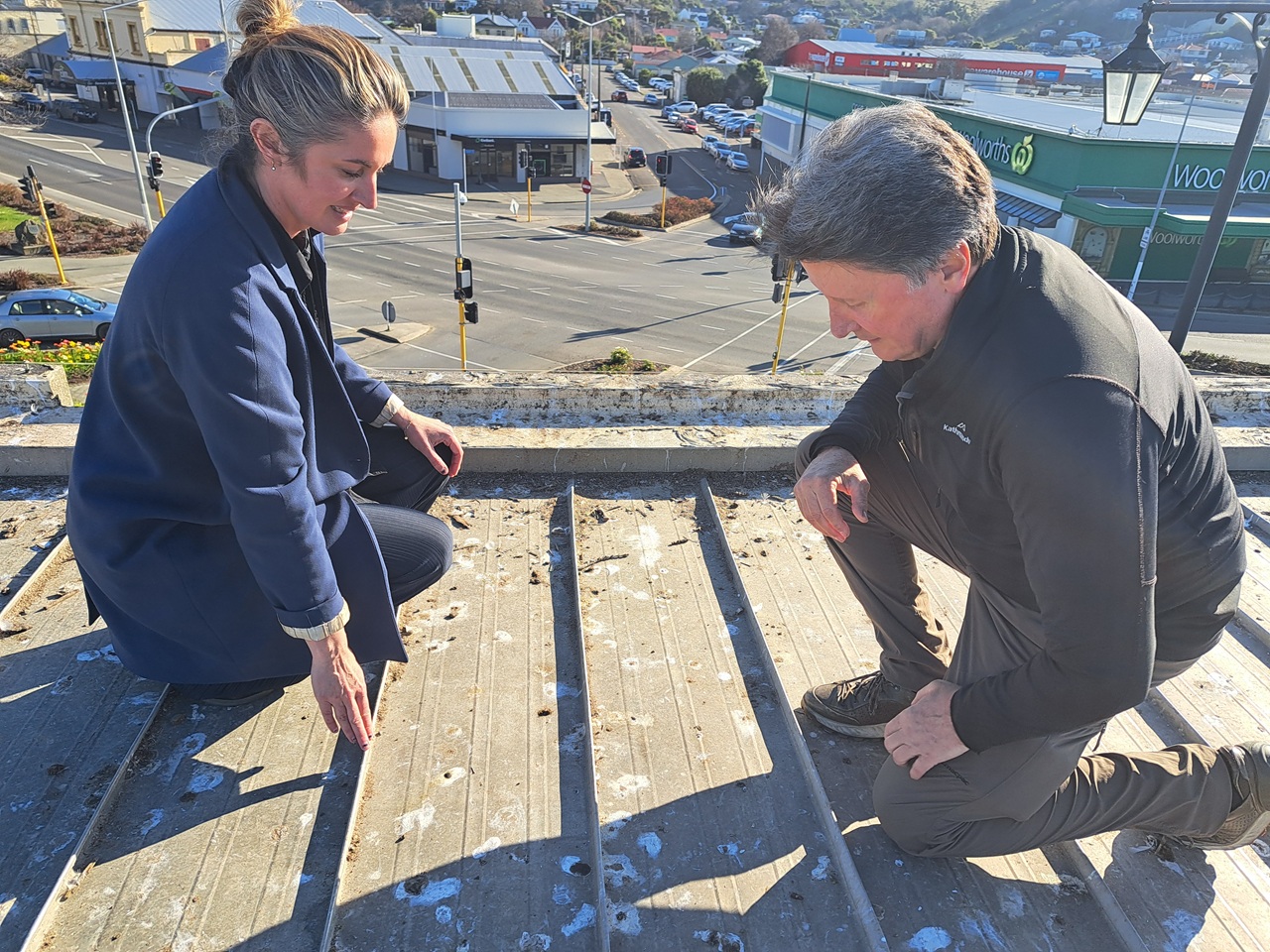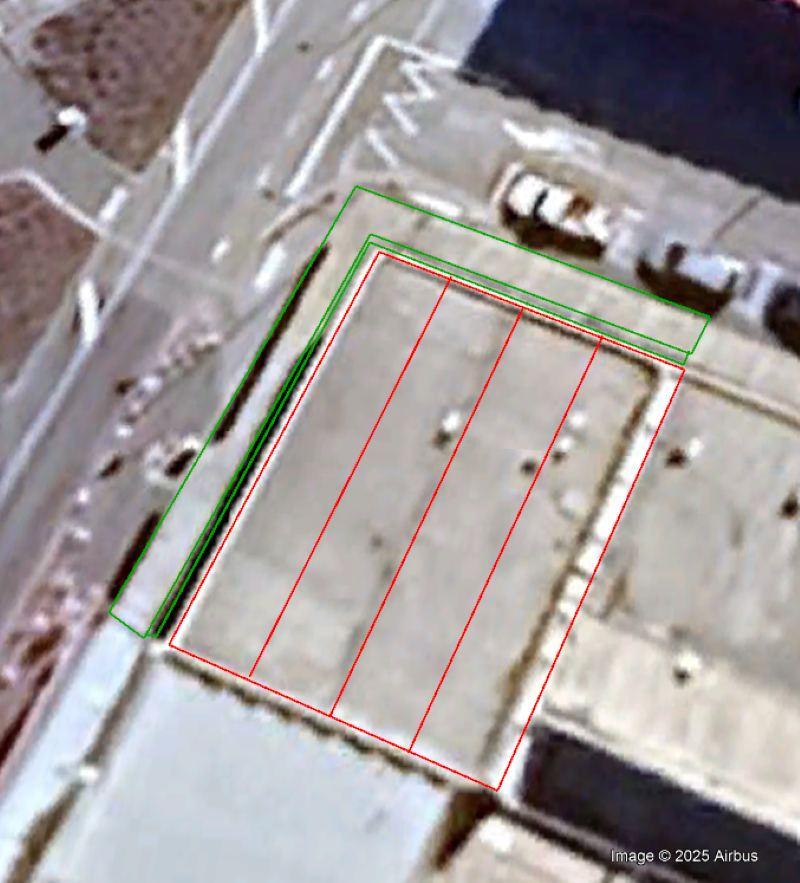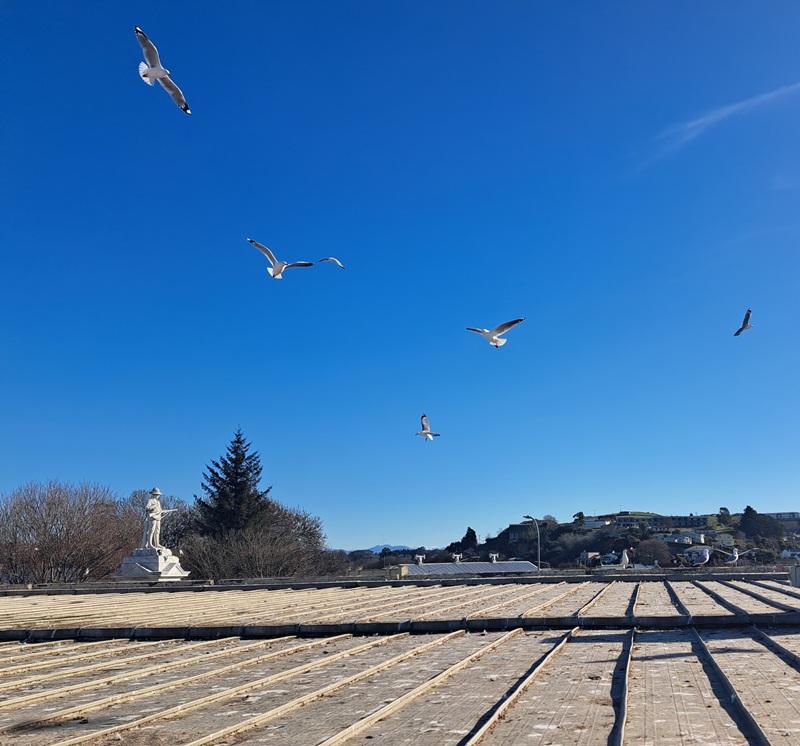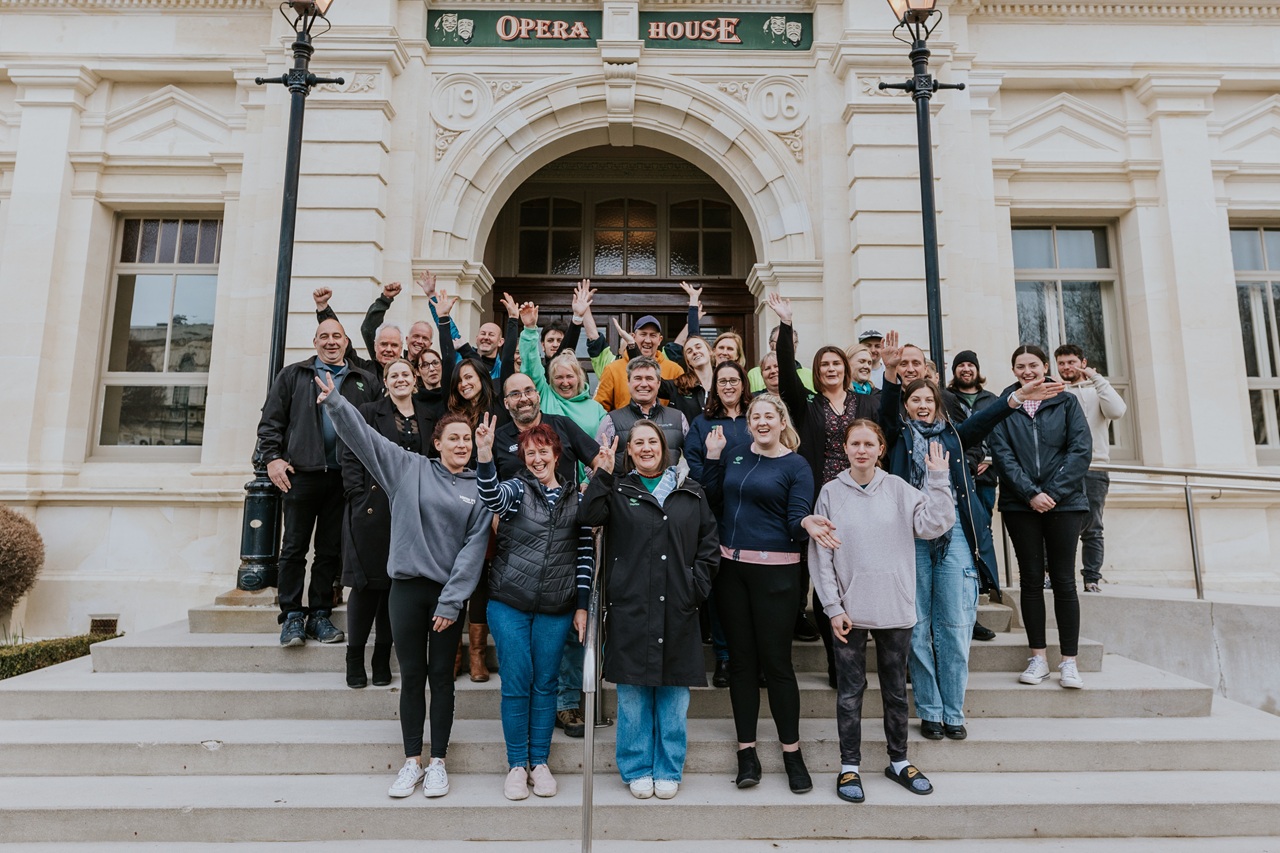Plugging in to new seagull deterrent could be the answer for Ōamaru businesses
Ashley Smyth
29 July 2025, 9:26 PM
 Business South Waitaki navigator Rebecca Finlay and Active Oxy director Brendon Spooner talk about the installation of a seagull deterrent on a Thames Street business roof. Photo: Ashley Smyth
Business South Waitaki navigator Rebecca Finlay and Active Oxy director Brendon Spooner talk about the installation of a seagull deterrent on a Thames Street business roof. Photo: Ashley SmythFor Ōamaru business owners dreading the encroachment of another seagull breeding season, help may be on the way.
A revolutionary system which uses electricity to deter the “nationally vulnerable” birds from nesting is being trialled in Ōamaru.
Active Oxy director Brendon Spencer is working with Business South Waitaki navigator Rebecca Finlay to see if the system is a viable option for businesses struggling with the noise and mess created by the mostly red-billed gulls which, once they start breeding, cannot have their nests disturbed.
Brendon says his Christchurch-based business to this point has mostly been installing ozone (O3) systems to deter nuisance birds from indoor areas, such as food and seed storage, processing facilities and farm buildings.
The ozone gas, made of three oxygen atoms, is used at a regulated level to make the birds feel uncomfortable, but does not harm them, and encourages them to fly elsewhere.
Brendon has been looking to implement a product that works on the outside of buildings, as ozone dissipates quickly and is less effective outdoors.
The new system, which he will begin trialling on the roof of 149 Thames Street at the start of August (above Don the Barber), is a plug-in system, which uses electromagnetic pulses.
“It does two things really. It makes the birds feel a sensation of vertigo, and it interferes with their guidance system. It disorients them slightly, they don’t like it, and they refuse to land on the buildings with this system installed.”
He says the building is “almost perfect” for the trial, because the roof has two levels.
“So we've got a treated area and a control area all in the one space . . . The high roof's going to be treated, the lower roof's not. So we'll see, like if they stay off that one and go onto that one, then it's a thumbs up.”
The pulse goes out about 8m, and the length of the wire is between 70m and 180m, and that can be woven around the area. The power it uses is “negligible”.

The red and green lines indicate where wires will be installed, to deter seagulls from the roof. Photo: Supplied
The system, which uses technology from overseas, has been used in Blenheim and other buildings around New Zealand with promising results.
These installations were carried out by a Blenheim business called Hitman Pest Management, owned by Leighton Hynes, who Brendon is also consulting with on this project.
“I'm going to involve him, because if this does get some uptake, we're going to need more than me,” Brendon says.
“In Ōamaru we will be using similar technology that Leighton has successfully installed on the Marlborough Library (Te Kahu o Waipuna), but a different system, and from another company.”
The system installed on the Blenheim library was activated in March 2024 and has been operating since that time, and seagulls are no longer an issue on that roof, he says.
If this system works for Ōamaru, it will be the most affordable option, Brendon says.
“So we've, neither of us, had experience with this one before, so it'd be good to put this one in. And then we can choose between three.”
They are not charging for their time or for the product.
“I want to see how good it is compared to the one in Blenheim that is regulated differently.
“So, it's a matter of sharing the love, if that makes sense.”
Rebecca says it is an exciting possibility for Ōamaru businesses and shoppers, who are often plagued by the protected birds and the mess they make, there is hope that finally, something can be done about the problem.
As soon as the system is installed it will be monitored, and it will stay there, with little intervention required except occasional maintenance.

Seagulls coming in for landing on top of 149 Thames St. Photo: Ashley Smyth
It will only be a matter of days before they know whether it is working, and there is the potential to offer it to the wider community ahead of this year’s breeding season, which tends to be around spring.
While he couldn’t be specific about costs, the system is cheaper than the netting which is covering the Ōamaru Woolworths roof, he says.
“What it does is, birds are at their most vulnerable when they're landing. And this works in that area of their flight.
“So it's a proactive treatment as opposed to a reactive treatment, it's designed to deter them as they're coming in at their most vulnerable.”
The Thames St building’s property manager Kevin McLay says if this system works, it will be worth the cost, when he takes into consideration the time he spends cleaning up the mess the birds make.
“The stink of seagulls, especially when they're nesting,” he says. “And, because then they block up the gutters, then it rains, then it floods, then you've got mould and it just goes on.”
Rebecca says there are all kinds of ramifications by not being able to adequately protect your building from seagulls and nesting seagulls.
“Some businesses are at their wit’s end,” she says.
“There's all kinds of social and environmental effects . . . you don't want to walk and shop. And we need people to walk and shop. Footfall is the most effective way to keep the high street alive.
“Also thinking about potential implications for hospitality businesses for people who want to eat outside. The gulls in the Octagon (in Dunedin) are sort of aggressively targeting people dining outside.”
Business South has several members in the hospitality sector, and recognises it's important for urban vibrancy to have people dining al fresco, Rebecca says.
“There's all kinds of studies about footfall, getting outside, occupying your street frontage, that increases vibrancy in a city.”
She wonders if there might be some way to spread costs across businesses.
“There could be some way that we can bring all the building business owners together down this portion of Thames Street,” Rebecca says. “Because we're aware that we don't want to just push the problem to the next building.”
Waitaki District Mayor Gary Kircher says the council continues to provide advice to business owners to assist them in keeping seagulls off their buildings, and any new initiatives are “most welcome”.
“It’s been a long process to get us to where we are now, including providing areas for seagulls to nest and breed, as an alternative to our community’s buildings.
“We also work closely with the Department of Conservation to manage any specific problems.
“It is very much a case of welcoming any initiatives that keep the birds in areas where any interaction with humans is minimised,” he says.
NEWS
WHAT'S ON GUIDE
SOCIAL






